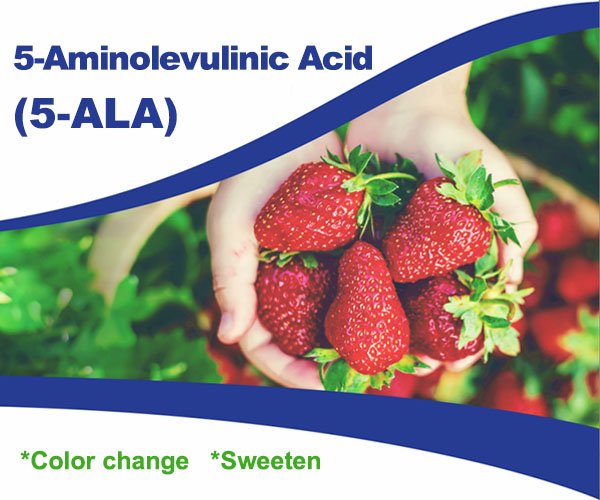5-Aminolevulinic acid (5-ALA) is a natural compound found in all living things. It is known to be an important biosynthetic precursor of tetrapyrrole compounds such as chlorophyll, heme, vitamin B12, and phytochromes. Therefore, it is involved in photosynthesis, respiration and many other physiological processes.
As herbicide
5-ALA is a photodynamic herbicide, or tetrapyrrole-dependent photodynamic herbicide, which can disrupt normal tetrapyrrole metabolism and thereby damage plant cells. ALA can also selectively kill dicotyledonous weeds in wheat, corn or other crops. ALA, on the other hand, acts as a poison in chemical herbicides at low concentrations and as a herbicide at high concentrations.
5-Aminolevulinic acid as pesticide
Rebeiz et al. proposed that ALA can cause biochemical metabolism imbalance in lepidopteran and dipteran insects such as trichoptera, fruit flies, cockroaches, etc., leading to convulsions and even death. ALA has the potential to act as an antigenotoxic agent against chemicals, which provides new insights into reducing genetic damage in plants under chemical stress.
Bidirectional regulation of probiotics and pathogens
5-ALA induces porphyrin synthesis and photodynamically inactivates Escherichia coli, making it useful as a food surface disinfectant. Studies have shown that ALA can promote the growth of probiotic fungi while inhibiting the proliferation of pathogenic fungi.
Plant Growth Regulator
(1) Application in plant tissue culture
5-Aminolevunilic Acid is not a plant hormone, but it has regulatory activity more than any typical plant hormone. 5 ~ 10 mg/L ALA can induce the formation of adventitious buds and roots in Schizonepeta calli. ALA has the functions of both IAA and CTK and can be used in plant tissue culture and propagation.
(2) Promote seed germination
A large number of studies have shown that ALA can promote plant seed germination. When wheat seeds were soaked in 5 mg/L ALA solution for 4 hours, not only the germination rate was improved, but the growth of young roots and shoots was also promoted. ALA of 40 ~ 160 mg/L can improve the salt tolerance of milk thistle seed germination and seedling growth.
(3) Improve plant growth and crop yield
Low concentrations of ALA can promote the growth and yield of many crops, however, 100 mg/L ALA will reduce crop yields. The timing and concentration of ALA application are critical to improving yield.
(4) Improve plant stress resistance
In terms of stress resistance, ALA can improve plants’ resistance to high temperatures, low temperatures, strong light, low light, drought, waterlogging, saline-alkali, barrenness, heavy metal pollution, mineral oil pollution, traffic exhaust pollution, elevated CO2, chemical pesticide poisoning, etc. Abiotic stress capability can also improve plant resistance to biotic stresses such as pathogenic fungal infection and root-knot nematode damage. In photosynthesis, ALA participates in the regulation of the entire process. In stress tolerance, ALA induces preventive and protective systems in plants through the NO/H2O2 signaling network.
Application of 5-Aminolevunilic Acid(5-ALA) at different cencentration:
- 5-ALA can be used as a biological pesticide, fungicide and herbicide when the concentration is higher than 838 mg/L (about 5 mmol/L).
- When the ALA concentration is 100~300 mg/L, it can be used to remove excess flowers in spring orchards, promote the development of young fruits, and promote fruit coloring before maturity.
- When the concentration is lower than 100 mg/L (especially not higher than 10 mg/L), ALA can be used as a new plant growth regulator to promote seed germination, promote plant (including roots and stems) growth, and enhance stress tolerance. properties, increase crop yields and improve product quality.
Original text from Forests:Wang, L.; Zhang, J.; Zhong, Y.ect. Regulation of 5-Aminolevunilic Acid and Its Application in Agroforestry.


